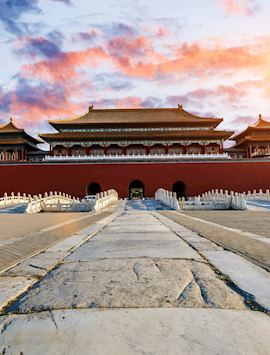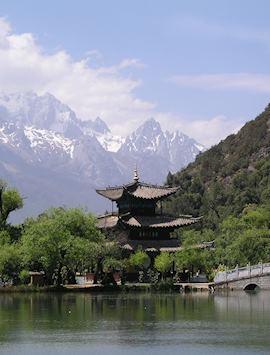By China specialist Alice
Whether you're a first time visitor or an old hand, China's beguiling mix of age-old history and high-tech development is simply irresistible. It's a destination that gets under your skin. The kind of place where you can peel back more layers on each visit, revealing something new each time.
On your first trip you'll probably want to include some of China's better known highlights. The most popular attractions can get busy though, and a little local knowledge goes a long way to experiencing these landmarks in peace.
Tour the Forbidden City in Beijing

The largest palace complex in the world, the Forbidden City is an ancient seat of government that was kept hidden from the public for 500 years. Its magnificent proportions and regal opulence reflect the wealth and power of the 24 emperors who ruled from here. There are 980 buildings in the complex, ranging from grandiose halls to more modestly decorated side rooms. On first arrival it can seem a little overwhelming.
Take it slowly so you can soak up the history, architecture and atmosphere, and examine the impressive museum artefacts. The Forbidden City is one of the most popular things to do in Beijing and it can get very busy. However, a good guide will help you avoid the crowds by visiting at quieter times and taking you away from the tourist groups.
Visit the Terracotta Warriors in Xi'an

One of the world's most famous archaeological finds, the Terracotta Warriors were built in 210 BC to guard the soul of China's first emperor on his journey into the afterlife. There are over 10,000 life-size figures in this vast silent army and all are arrestingly lifelike with detailed facial expressions and clothing. It's thought that each warrior bears the face of the workman who created it, perhaps in the hope of preserving something of themselves in the afterlife too.
This compelling site is best seen with a guide who will explain the history of its construction and of its discovery, and lead you through the pits in such a way as to avoid the worst of the crowds. The subterranean army was only discovered in 1974 by a farmer digging a well, and on my first visit I was lucky enough to meet him in the souvenir shop.
Walk along The Great Wall at Jinshanling

I'll never forget the moment I first saw the Great Wall. Its magnitude has to be seen to be believed, and the weight of its history really only sinks in as you walk from tower to tower, the wall endlessly snaking away into the distance.
Of all China's attractions, this is the one that left the biggest impression on me. It truly is an exceptional place, especially when you think that parts of the wall were built in 220 BC and it eventually covered over 21,000 kilometres.
It’s worth journeying slightly further away from Beijing, to Jinshanling, to escape the crowds and see a part of the wall that retains some of its original form and natural features, battle scars and all. After walking along the wall you can take a cable car down the mountainside to admire the views.
Cruise through the karst peak scenery of Yangshuo

The Li River winds its way through a dramatic landscape of steep-sided limestone pinnacles dotted with bamboo groves and villages where locals still fish with cormorants. A cruise from Guilin to Yangshuo is a wonderfully gentle way to immerse yourself in this beautiful scenery which, since classical times, has formed a key motif in Chinese art and literature.
It’s a four- to five-hour boat ride that offers an insight into village life. Children play on the shores while their mothers wash clothes, and local fishermen sell fruit from passing rafts or transport their catch to the nearby towns.
I'd recommend spending two nights in the bustling town of Yangshuo as there are some exceptionally picturesque villages nearby and the option to take a cookery course overlooking the rice paddies.
A favourite experience of mine, you'll be guided around the lively morning markets to pick your ingredients before preparing and cooking four dishes, which might include beer fish (a local speciality), gong bao chicken (a dish flavoured with chilli, ginger and peanuts), spiced vegetables and dumplings.
Feast on Hong Kong cuisine

A fascinating blend of old and new, Hong Kong offers numerous attractions and experiences from traditional markets to designer malls. Of all the things to do in Hong Kong, however, eating out is one of the most memorable.
A fusion of Western style and Asian flavours, the food here blends influences from all over the globe and you can enjoy anything from high tea to exquisite dim sum. Although the food is mostly Cantonese in origin, you'll find plenty of regional variants, Japanese influences and Michelin-starred celebrity chefs too.
Egg tart, a delicious pastry filled with smooth egg custard, is a Hong Kong staple and the Hoover Cake Shop in Kowloon makes the best I have eaten, drawing crowds from all over the city. Wherever you decide to eat, wear comfortable clothing; portions are large and most dishes are served with a generous carbohydrate-rich side.
Meet the native minorities in Yunnan

One of my favourite provinces in China, Yunnan is known for its striking mountain scenery and diverse ethnic groups. By visiting with a good guide you can gain a real insight into the daily lives and routines of the local people.
In the Himalayan foothills, Dali's old walled town dates back to the Ming dynasty and still retains a wealth of traditional Bai architecture, typified by white walls and intricate roof details. Nearby, the small town of Xizhou is another example of Bai tradition and culture, its marvellous market bright with beautifully attired tribal people in traditional costume.
The remarkably well-preserved old town of Lijiang, a key point on the ancient Tea Horse trading route, which linked Yunnan with Bengal via Myanmar, is also worth a visit.
A very popular stop on domestic China tours, its cobbled streets are lined with waterways and flanked by Qing dynasty architecture. The buildings have wooden walls with distinctive grey tiled roofs, which flair out at the bottom, often with a band of bright detailing marking each floor of the building.
The surrounding villages, such as Baisha, once the capital of the Naxi Kingdom, are fascinating to explore with traditional music, scripture and embroidery still shaping the way the local people live today.
Ensuring the survival of Pandas in Chengdu

The swaying bamboo forests of Sichuan's northern mountain ranges are home to the reclusive giant panda. Rarely seen in the wild, at Chengdu’s panda sanctuary you can observe these endearing creatures in as close to their natural habitat as possible.
The sanctuary focuses on conservation and it's best to visit in the morning when it’s quiet and the pandas are feeding. In the afternoon they often wander off to sleep for the day. If you're lucky you may see some adorable new panda cubs, which is a real treat.
Hike along the Dragon’s Backbone rice terraces

Row upon row of tiered rice terraces coil around the mountainsides in Longji, in an area known as the Dragon's Backbone. Hiking through the terraces offers unsurpassed views of the ever-changing mountains, while spending a night in one of the small villages is a great opportunity to experience a traditional rural way of life.
You’ll see women drying chillies on the edge of paths, and men and women barefoot amid the rice. Once the day's crowds have moved on, peace falls on the mountains and you can enjoy a delicious meal of black pepper beef or twice fried pork at Green Garden Restaurant whilst looking out to the green ribboned pastures. If your hotel room overlooks the terraces, try to wake up at sunrise as they glitter in the dawn light.
Go to a festival in Guizhou

There are 49 ethnic minorities living in the mountainous province of Guizhou and their myriad customs and costumes can be seen at some of the many festivals held here each year.
The Miao are one of the main groups here and you can stay in one of their villages or attend their festivals. The Lusheng Festival in October or November marks their hopes for a good harvest and health in the year to come and is celebrated by boys playing the lusheng, a traditional bamboo reed instrument, while girls in Miao costumes and headdresses dance along.
The Sisters Meal Festival in April, by contrast is a riotous celebration of drumming, singing, dancing, bullfighting and horse racing.
Start planning your trip to China
Start thinking about your experience. These itineraries are simply suggestions for how you could enjoy some of the same experiences as our specialists. They're just for inspiration, because your trip will be created around your particular tastes.
View All Tours in ChinaFurther reading
- Everything you always wanted to know about China (but were afraid to ask)
- A guide to Chinese food (and where to find it)
- The slow side of China: visiting the rural provinces
- China’s modern cities: Shanghai and Hong Kong
- Kung fu, cooking and pandas: family travel in China
- The Great Wall of China: taking a quieter path
- Our guide to exploring the Terracotta Army of Xian
- How to see pandas in China: everything you need to know
- Characterful stays in China





